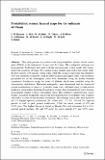| dc.contributor.author | El-Hussain, I. | |
| dc.contributor.author | Deif, A. | |
| dc.contributor.author | Al-Jabri, K. | |
| dc.contributor.author | El-Hady, S. | |
| dc.contributor.author | Al-Hashmi, S. | |
| dc.contributor.author | Al-Toubi, K. | |
| dc.contributor.author | Al-Shijbi, Y. | |
| dc.contributor.author | Al-Saifi, M. | |
| dc.contributor.author | Kuleli, Huseyin Sadi | |
| dc.contributor.author | Toksoz, M. Nafi | |
| dc.date.accessioned | 2017-01-12T21:23:29Z | |
| dc.date.available | 2017-01-12T21:23:29Z | |
| dc.date.issued | 2012-06 | |
| dc.date.submitted | 2011-12 | |
| dc.identifier.issn | 0921-030X | |
| dc.identifier.issn | 1573-0840 | |
| dc.identifier.uri | http://hdl.handle.net/1721.1/106473 | |
| dc.description.abstract | This study presents the results of the first probabilistic seismic hazard assessment (PSHA) in the framework of logic tree for Oman. The earthquake catalogue was homogenized, declustered, and used to define seismotectonic source model that characterizes the seismicity of Oman. Two seismic source models were used in the current study; the first consists of 26 seismic source zones, while the second is expressing the alternative view that seismicity is uniform along the entire Makran and Zagros zones. The recurrence parameters for all the seismogenic zones were determined using the doubly bounded exponential distribution except the zones of Makran, which were modelled using the characteristic distribution. Maximum earthquakes were determined and the horizontal ground accelerations in terms of geometric mean were calculated using ground-motion prediction relationships developed based upon seismic data obtained from active tectonic environments similar to those surrounding Oman. The alternative seismotectonic source models, maximum magnitude, and ground-motion prediction relationships were weighted and used to account for the epistemic uncertainty. Hazard maps at rock sites were produced for 5 % damped spectral acceleration (SA) values at 0.1, 0.2, 0.3, 1.0 and 2.0 s spectral periods as well as peak ground acceleration (PGA) for return periods of 475 and 2,475 years. The highest hazard is found in Khasab City with maximum SA at 0.2 s spectral period reaching 243 and 397 cm/s[superscript 2] for return periods 475 and 2,475 years, respectively. The sensitivity analysis reveals that the choice of seismic source model and the ground-motion prediction equation influences the results most. | en_US |
| dc.description.sponsorship | Oman Ministerial Cabinet (project number 22409017) | en_US |
| dc.publisher | Springer Netherlands | en_US |
| dc.relation.isversionof | http://dx.doi.org/10.1007/s11069-012-0232-3 | en_US |
| dc.rights | Creative Commons Attribution-Noncommercial-Share Alike | en_US |
| dc.rights.uri | http://creativecommons.org/licenses/by-nc-sa/4.0/ | en_US |
| dc.source | Springer Netherlands | en_US |
| dc.title | Probabilistic seismic hazard maps for the sultanate of Oman | en_US |
| dc.type | Article | en_US |
| dc.identifier.citation | El-Hussain, I. et al. “Probabilistic Seismic Hazard Maps for the Sultanate of Oman.” Natural Hazards 64.1 (2012): 173–210. | en_US |
| dc.contributor.department | Massachusetts Institute of Technology. Department of Earth, Atmospheric, and Planetary Sciences | en_US |
| dc.contributor.mitauthor | Kuleli, Huseyin Sadi | |
| dc.contributor.mitauthor | Toksoz, M. Nafi | |
| dc.relation.journal | Natural Hazards | en_US |
| dc.eprint.version | Author's final manuscript | en_US |
| dc.type.uri | http://purl.org/eprint/type/JournalArticle | en_US |
| eprint.status | http://purl.org/eprint/status/PeerReviewed | en_US |
| dc.date.updated | 2016-08-18T15:19:21Z | |
| dc.language.rfc3066 | en | |
| dc.rights.holder | Springer Science+Business Media B.V. | |
| dspace.orderedauthors | El-Hussain, I.; Deif, A.; Al-Jabri, K.; Toksoz, N.; El-Hady, S.; Al-Hashmi, S.; Al-Toubi, K.; Al-Shijbi, Y.; Al-Saifi, M.; Kuleli, S. | en_US |
| dspace.embargo.terms | N | en |
| dc.identifier.orcid | https://orcid.org/0000-0002-1875-1625 | |
| dc.identifier.orcid | https://orcid.org/0000-0002-4851-3089 | |
| mit.license | OPEN_ACCESS_POLICY | en_US |
